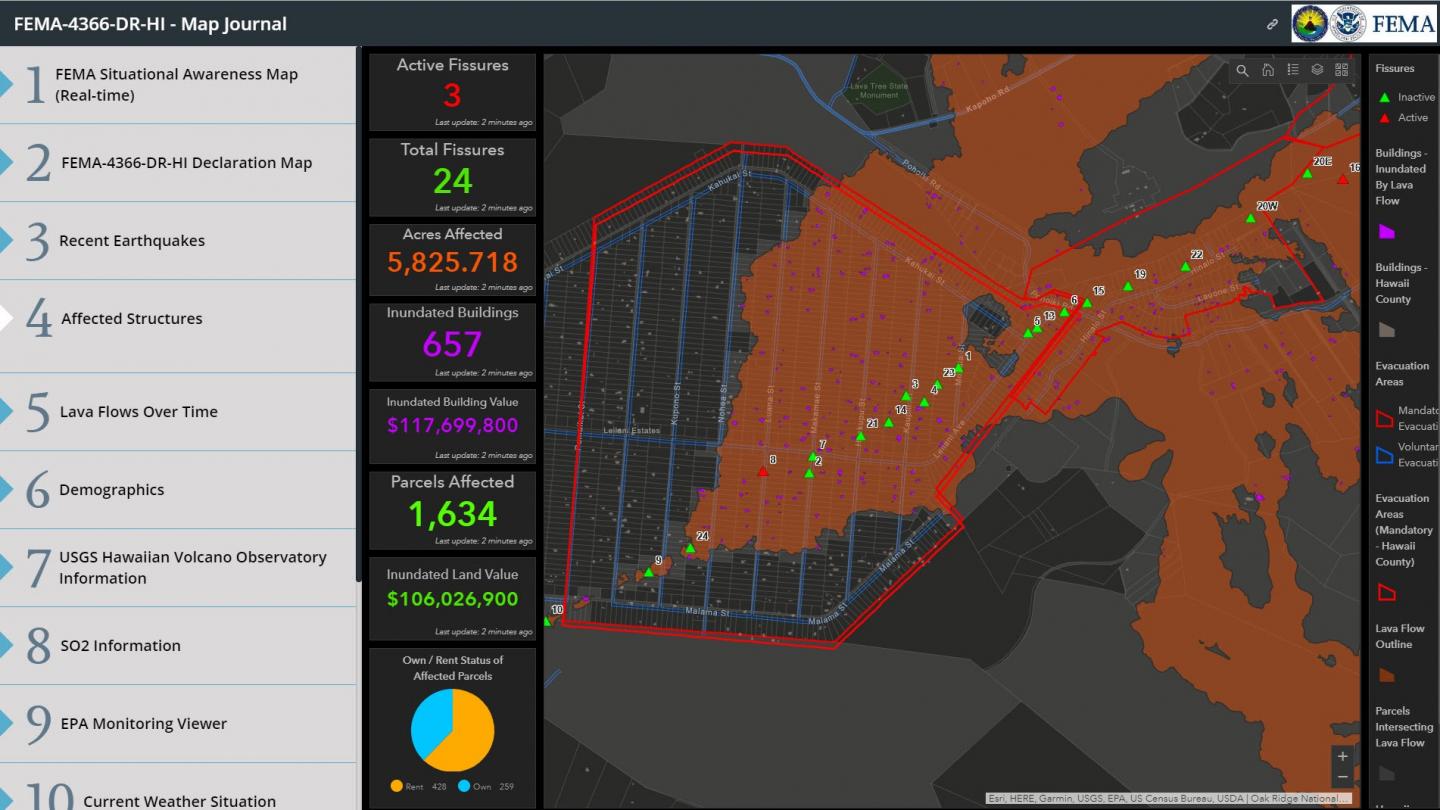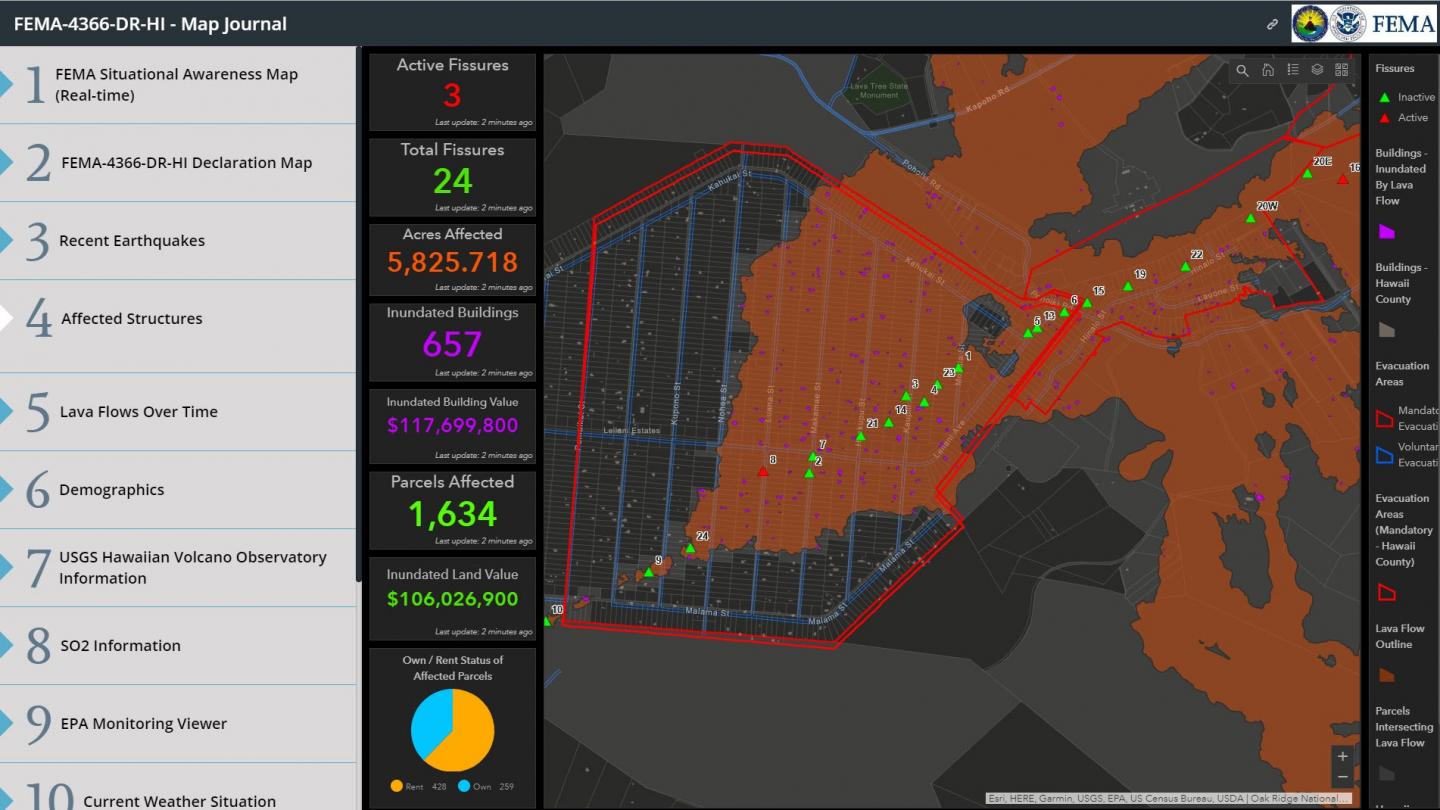
Credit: Federal Emergency Management Agency
Datasets–Assessing lava flow impacts
Geospatial data from Oak Ridge National Laboratory is supporting emergency response to destructive volcanic activity in Hawaii. Researchers provided the Federal Emergency Management Agency with information on buildings and structures that was rapidly extracted from satellite imagery using novel deep learning techniques. Ongoing eruptions from the Kilauea volcano since May have opened fissures of flowing lava across the Big Island, damaging more than 700 homes. Identifying and characterizing vulnerable and affected structures, such as residences, businesses, schools and hospitals, are major aspects of emergency response and post-impact damage assessments. "Our expertise with large datasets combined with high-performance computing resources gives us the ability to provide this information very quickly," said ORNL's Mark Tuttle. His team processed data focused near Kilauea in less than a day and all visible structures on the entire Island of Hawaii in two weeks. [Contact: Ashley Huff, (865) 241-6451; [email protected]]
Image: https://www.ornl.gov/sites/default/files/news/images/FEMA-Hawaii.jpg
Caption: Researchers at Oak Ridge National Laboratory contributed buildings and structures datasets to the Federal Emergency Management Agency to support emergency response following major volcanic eruptions on the Island of Hawaii. Combined with other mapping layers–such as lava flows, outlined in red, and active or inactive fissures, shown in red or green triangles, respectively–structural information helps identify immediate risks or hazards and aids in damage assessment. Credit: Federal Emergency Management Agency
Chemistry–Polymer, heal thyself
An Oak Ridge National Laboratory-led team has developed super-stretchy polymers with amazing self-healing abilities that could lead to longer-lasting consumer products. The polymers are among the world's stretchiest and can elongate about 1,000 to 5,600 percent before breaking. After breaking, they can be healed with complete restoration of elasticity by merely touching adjacent pieces. By tailoring the properties of segments and how they link to the polymer, the scientists tuned tensile strength, toughness and elastic recovery. They used stretchy polymeric strips to create a permeable membrane that selectively separated two gases. After that membrane broke, it self-healed to once again separate the gases. Tailoring the degree of hydrogen bonding was the key to self-healing and could be exploited to make other self-healing materials. "These novel materials provide an attractive platform for fabrication of functional films, membranes, coatings and devices with prolonged lifetimes," said ORNL's Tomonori Saito. The work was published in Advanced Functional Materials. [Contact: Dawn Levy, (865) 576-6448; [email protected]]
Image: https://www.ornl.gov/sites/default/files/news/images/Super-stretchy-self-healing-material.jpg
Caption: Rubbery segments in a ribbon-shaped polymer membrane make it super-stretchy. Hydrogen-bonding molecules, shown as yellow and green spheres, allow the material to self-heal after a cut or break and recover its ability to separate gases such as carbon dioxide, shown as red and black spheres, from nitrogen, depicted as blue spheres. Credit: Pengfei Cao and Bingrui Li/Oak Ridge National Laboratory, U.S. Dept. of Energy
Materials – Printing with plants
A scalable processing technique developed by Oak Ridge National Laboratory uses plant-based materials for 3D printing and offers a promising additional revenue stream for biorefineries. Scientists created a new material with excellent printability and performance by tapping into lignin–a key component of plant cell walls that provides sturdiness. Lignin is a current byproduct of the biofuels process that could become a valuable coproduct with this new use. The method combines lignin, rubber, carbon fiber and acrylonitrile butadiene styrene, or ABS–commonly used in plastic toys–to 3D print structures with 100 percent improved weld strength between the layers over ABS alone. "To achieve this, we are building on our experience with lignin during the last five years," said ORNL's Amit Naskar. "We will continue fine tuning the material's composition to make it even stronger." The research team published details about the patent-pending process in Applied Materials Today. [Contact: Kim Askey, (865) 576-2841; [email protected]]
Image 1: https://www.ornl.gov/sites/default/files/Plant-based_3D-printed_material.jpg
Caption: Researchers at ORNL developed a scalable processing technique to 3D print a plant-based composite material. Credit: Ngoc Nguyen/Oak Ridge National Laboratory, U.S. Dept. of Energy
Image 2: https://www.ornl.gov/sites/default/files/Plant-based_3D-printed_material_micrograph.jpg
Caption: The micrograph shows a cross-section of the weld area between two 3D-printed layers of a plant-based composite material developed by Oak Ridge National Laboratory. Credit: Christopher Bowland/Oak Ridge National Laboratory, U.S. Dept. of Energy
Electricity–Mini-grid to the max
Oak Ridge National Laboratory engineers have devised a testbed that lets them mimic high-voltage equipment in a safe, low-voltage setting. The Software-Defined Intelligent Grid Research Integration and Development platform, or SI-GRID, operates below 100 volts–less than a household outlet– and has been used to develop communications and controls for microgrids. The platform gives researchers crucial information on how the grid functions when loads suddenly shift during a power outage, and how it can more quickly recover. It can, for instance, test protective relays that detect electrical faults and prevent damage to the network. "Traditionally, we would rely on computer models of the grid to figure out how new components will work," said Ben Ollis of ORNL. "With the higher fidelity of a physical system, we can better understand power quality issues and dynamics." The platform explores ways to monitor the grid, protect it from disturbances like storms and cyber intrusion and make it more resilient when power is disrupted. [Contact: Stephanie Seay, (865) 576-9894; [email protected]]
Image 1: https://www.ornl.gov/sites/default/files/SI-GRID_1.jpg
Caption: Ben Ollis, left, and Phil Irminger of Oak Ridge National Laboratory's Power and Energy Systems Group test components on the SI-GRID platform in a safe, low-voltage setting. Credit: Carlos Jones/Oak Ridge National Laboratory, U.S. Dept. of Energy
Image 2: https://www.ornl.gov/sites/default/files/SI-GRID_2.jpg
Caption: ORNL researchers insert a device to be tested on the SI-GRID platform. Credit: Carlos Jones/Oak Ridge National Laboratory, U.S. Dept. of Energy
Neutrons–Making sustainable biofuels
Scientists at Oak Ridge National Laboratory are using neutrons to understand why certain hydrocarbons produced by blue-green algae are important to their biology, so new strains can be engineered to sustainably produce biofuels. Neutron scattering makes it possible to non-destructively see inside living algae at real world temperatures and in real time. "No one has used neutron scattering to test the hypothesized role hydrocarbons in modulating membrane structure in algae," said Cory Knoot of the Washington University in St. Louis. "Understanding why alkanes are important to cyanobacterial health could make it easier to engineer new strains of the algae that can sustainably produce alkanes as biofuels." Knoot used the lab's Biological Small-Angle Neutron Scattering, or Bio-SANS, instrument, which is designed and optimized to analyze the structure, function and dynamics of complex biological systems. [Contact: Kelley Smith, (865) 576-5668; [email protected]]
Image: https://www.ornl.gov/sites/default/files/neu.png
Caption: Postdoctoral researcher Cory Knoot prepares a sample of blue-green algae for neutron scattering experiment on the Bio-SANS instrument at ORNL's High Flux Isotope Reactor. Credit: Kelley Smith/Oak Ridge National Laboratory, U.S. Dept. of Energy
###
Media Contact
Sara Shoemaker
[email protected]
865-576-9219
@ORNL
http://www.ornl.gov
Original Source
https://www.ornl.gov/news/story-tips





